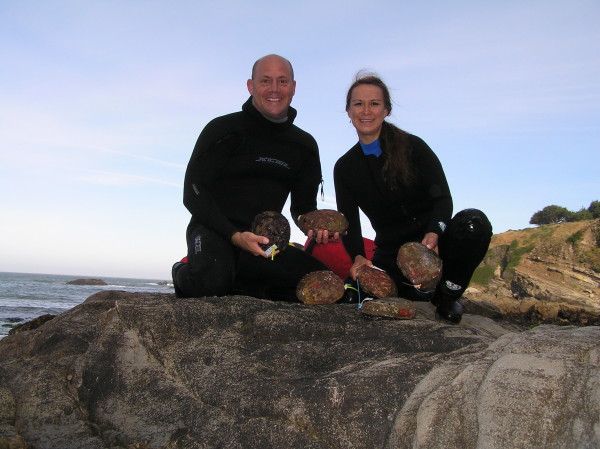
California’s popular red abalone sport fishery season will open April 1 in most waters north of San Francisco Bay. However, new regulations effective last year closed parts of Fort Ross State Historical Park to the take of abalone. A map of the closed area can be found online athttp://nrm.dfg.ca.gov/FileHandler.ashx?DocumentID=42101&inline=true.
The California Department of Fish and Wildlife (CDFW) also enacted regulations last year that changed the start time from one-half hour before sunrise to 8 a.m. People may travel to fishing locations before 8 a.m. but may not actively search for or take any abalone before that time. The limit on abalone cards was also reduced from 24 to 18, but only a total of nine can be taken from Sonoma and Marin counties.
The changes were made because abalone abundance at eight index sites monitored by CDFW has declined over the years and the Abalone Recovery and Management Plan required a reduction in take. The 8 a.m. start time was proposed by CDFW wildlife officers who were witnessing large numbers of fishermen every low tide, and because it was becoming more difficult to find legal sized abalone (seven inches or greater measured along the longest shell diameter). During the search for legal sized abalone, increasing numbers of undersized abalone were being removed for measurement. It is likely that many abalone do not survive handling. The later start reduces the number of low tide days available for taking abalone, as well as the numbers of abalone taken and the number of undersized abalone killed during the search for legal sized abalone.
A complete list of abalone fishing regulations is available in the 2015 Ocean Sport Fishing Regulations booklet, which is available wherever fishing licenses are sold or atwww.dfg.ca.gov/marine/sportfishing_regs2014.asp.
Abalone licenses and report cards may be purchased online atwww.wildlife.ca.gov/licensing/fishing .
Cards should be returned to CDFW’s Fort Bragg office, 32330 North Harbor Dr., Fort Bragg, CA 95437-5554. The return deadline is Jan. 31, 2016 but cards can be submitted early. The licensing webpage linked above also has a tab for reporting abalone catch online which may be done in place of returning the card by mail.
Abalone report cards must be returned even if no abalone were taken or no attempt was made to take abalone.
Abalone cling to rocks, from wave-swept intertidal ledges to deep ocean reefs, where they feed on kelp and other algae. It can take 12 years or more for abalone on the north coast to grow to legal size for harvest and biologists have concerns about the ability of the fishery to sustain current catch rates. Similar to rockfish, abalone are a long-lived species but have generally low rates of reproduction. The last major recruitment event for red abalone occurred more than 25 years ago and recent dive surveys have recorded lower densities of abalone at eight index sites.
Currently, the only ongoing abalone fishery in California is in the northern region of the state, which has remained productive for nearly 60 years. In 2013, the last year numbers are available, the catch estimated from abalone cards and telephone surveys was 230,000. The average catch has been about 254,000 annually for the past 12 years.




